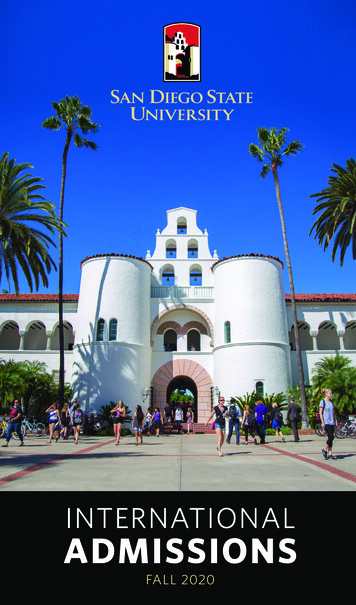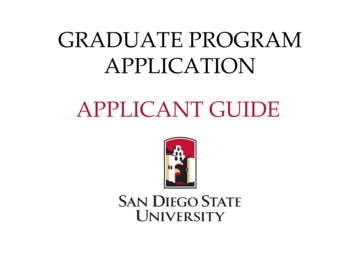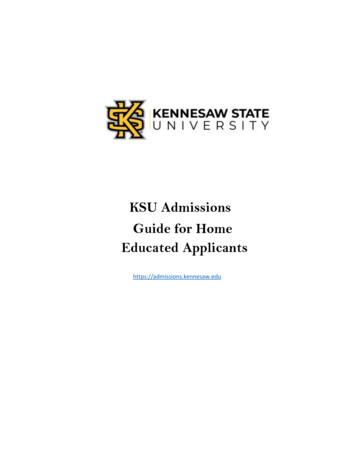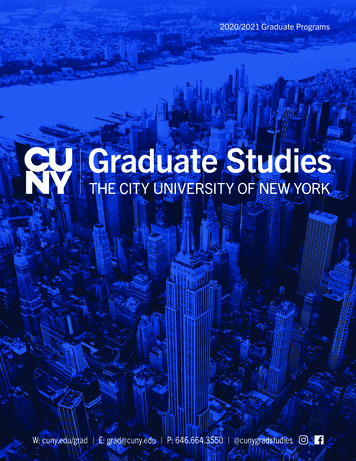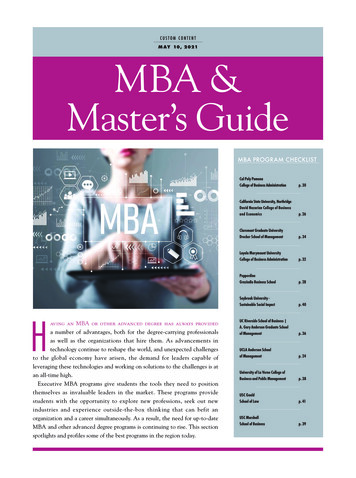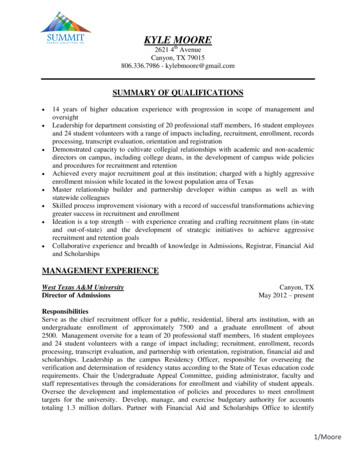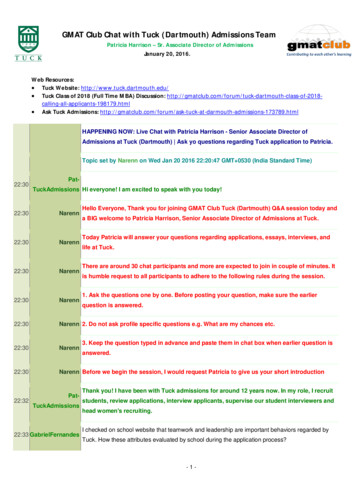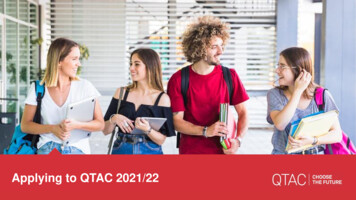
Transcription
THE INTERNATIONAL MEDICAL ADMISSIONS TEST(IMAT) SPECIFICATIONIn partnership withMinistero dell'Istruzione, dell'Università e della Ricerca (MIUR),the Italian Ministry of Higher Education and ResearchSeptember 2021
1 UCLES 2021
The International Medical Admission Test (IMAT)The International Medical Admissions Test (IMAT) is a subject-specific admissions test inEnglish, designed by Cambridge Assessment, for applicants to Medicine and Surgerycourses at Italian International Medical Schools.These courses are taught in English, with places open to both home and internationalstudents. Cambridge Assessment works in conjunction with the Italian Ministry of HigherEducation and Research (MIUR) to develop and deliver IMAT, which is the Englishlanguage equivalent of the Italian admissions test used for entry to medical degrees taughtin Italian.Test SpecificationTest FormatIMAT is a pen-and-paper test, consisting of a total of 60 multiple-choice questions dividedinto four sections. All questions have five options, of which only one is correct. Candidateshave 100 minutes to complete the test and the format is as follows:Section 110 questions - Logical Reasoning12 questions - General KnowledgeSection 218 questions - BiologySection 312 questions - ChemistrySection 48 questions - Physics and MathematicsScoringA candidate’s total score is calculated using the following formula:1.5 points for each correct answer;-0.4 points for each wrong answer;0 points for each question not answered.An overall total score (maximum 90 points) will be reported, together with a score on eachof Logical Reasoning, General Knowledge, Biology, Chemistry, Physics and Mathematics.Level of DifficultyThe level of difficulty of the test items will be targeted to discriminate effectively betweenapplicants, including those who may have achieved the highest possible grades in schoolexaminations.2 UCLES 2021
Section 1: General Knowledge and Logical ReasoningSection 1 will assess general knowledge and the thinking skills that students must possessin order to succeed in a course of study at the highest level. Such skills are basic to anyacademic studies, which often require students to solve novel problems, or considerarguments put forward to justify a conclusion, or to promote or defend a particular point ofview.General KnowledgeGeneral Knowledge questions may address a range of cultural topics, including aspects ofliterary, historical, philosophical, social and political culture.These questions are not based on any specific part of school curricula; rather their aim is totest the candidates’ interest and knowledge in a wide variety of fields. Candidates with akeen extra-curricular interest in current events who regularly keep up to date with nationaland international news will be better prepared to answer this type of question.Which country was governed by the Taliban’s theocratic regime from 1996 to 2001?ABCDEAfghanistanIranIraqSaudi ArabiaSyriaHere the correct answer is A.Logical ReasoningThe questions in this section evaluate candidates’ thinking skills, reasoning skills andanalytical skills, especially the ability to follow the logical steps in different contexts, torecognise fallacies in the argument, to solve problems, and to discern relevant fromirrelevant information.More specifically, there are two types of logical reasoning questions: Critical thinking: questions that involve reasoning using everyday written language.Questions focus on the skills involved in understanding and evaluating arguments. Problem Solving: questions that involve reasoning using numerical and spatial skills.In order to successfully answer these questions, candidates must employ a logicalapproach. No previous knowledge of any particular subject is necessary and all theinformation required to answer them is included in the question. Candidates are stronglyencouraged to familiarize themselves with the different types of questions by reading thisguide.3 UCLES 2021
Critical ThinkingIn this category there are 7 different specific types of questions that can appear in thissection of the test:1. Summarising the main conclusion2. Drawing a conclusion3. Identifying an assumption4. Assessing the impact of additional evidence5. Detecting reasoning errors6. Identifying parallel reasoning7. Applying principles1. Summarising the Main ConclusionThere has been a decline in the rate of many of the illnesses of old age. The causes ofthis decline include such medical advances as new drugs and surgical techniques.There is, however, another factor. The present generation of 60- and 70-year-olds hadmuch better nutrition as children than did their parents. Good nutrition in childhood isimportant for good health in adulthood. Since improvements in nutrition have continuedover the past sixty years, we can expect that many of the illnesses of old age willcontinue to decline.Which one of the following best expresses the main conclusion of the above argument?ABCDEWe can expect that improvements in nutrition will continue.The rate of many of the illnesses of old age has declined.Medical advances have significantly reduced the rate of diseases of old age.The fall in the rate of many of the illnesses associated with old age will continue.Improvements in nutrition have been very important in maintaining good health inold age.In this type of question you have to judge which one of the statements A to E bestexpresses the main conclusion of the argument. The conclusion can appear anywherewithin an argument - not necessarily at the end. What you are looking for is the statementwhich follows from, or is supported by the rest of the passage.In this case, D is the correct answer.4 UCLES 2021
2. Drawing a ConclusionThe demand for blood donors is increasing all over the world. In Western countries, inparticular, demand has been rising so rapidly that shortages have begun to appear. Inall such countries, demand is growing much faster than rates of growth in populationsaged 18–65, and it is this group who are the major blood donors. And, despite amassive research effort to find alternatives, it remains true that in medicine there is nosubstitute for human blood.Which one of the following conclusions can be drawn from the passage?ABCDEAs the demand for blood has increased, so has the supply fallen.The rate of growth of the blood-donor population has been slowing recently.The increase in the rate of demand for blood is mainly due to population growth.If more blood donors could be found, there would be no need to find a substitutefor human blood.The problem of the increase in demand for blood shows no sign of disappearing.In this type of question you are asked which conclusion follows from the information given.You need to consider each of the statements A to E, and to think about whether theinformation in the passage gives you good reasons to accept the statement.In this case, E is the correct answer.3. Identifying an AssumptionSuccess in modern America is very much measured by the quantity of materialpossessions one has. A lack of material possessions means one is judged to beunsuccessful. Those people with few material possessions therefore must feel a strongsense of failure.Which one of the following is an underlying assumption of the above argument?ABCDEMost modern Americans are successful.Success can be precisely measured.People in America with few material possessions want to be seen as successful.Excessive desire for material possessions is psychologically damaging.Over-emphasis on material possessions creates social problems.An assumption is something which is not stated in the argument, but which is taken forgranted in order to draw the conclusion. So you need first to identify the conclusion of theargument. Then look for the reasoning it gives to support this conclusion, and think aboutany important point which is not actually stated in the reasoning.In this case, C is the correct answer.5 UCLES 2021
4. Assessing the Impact of Additional EvidenceZoos are entirely unsuitable places for animals. People visit zoos to learn about animalbehaviour but the animals they see are likely to be behaving in abnormal and neuroticways because of the cramped and unnatural conditions in which they are kept. Zoosshould be closed and the money saved should be used for the protection of naturalhabitats.Which one of the following, if true, would most weaken the above argument?ABCDEHumans living in cramped conditions can also become neuroticZoos enable endangered species to survive by breeding them in captivity andthen re- introducing them to the wildMany of the animals at present in zoos would not be capable of living in the wildThe protection of natural habitats is very costlySchoolchildren can learn a great deal about animals from visiting zoosThis type of question will typically ask you to consider what would weaken or strengthen anargument. You need first to be clear about what the argument is trying to establish. Workout what the conclusion is, and then consider what effect each of the possible answerswould have on the conclusion.In this case, B is the correct answer.5. Detecting Reasoning ErrorsIn order to succeed in academic examinations it is necessary to study. Therefore, if astudent works hard in a particular subject, he or she should do well when it comes tothe examination.Which one of the following best describes the flaw in the argument?ABCDEIt assumes that it is necessary to study in order to succeed.It overestimates the value of studying in preparation for examinations.It ignores the fact that some subjects are more academic than others.It assumes that studying hard is a sufficient condition for academic success.It ignores the fact that some students do not need to study very much in order tosucceed.This type of question asks you to identify the flaw in the argument, which means that youmust explain why the conclusion does not follow from the reasons which are given. So youneed to be clear about what the conclusion is, and what reasons are meant to support it.In this case, D is the correct answer.6 UCLES 2021
6. Identifying parallel reasoningIf you want to earn a good salary these days, you have to gain considerable experienceof working abroad. Since I have always wanted to earn a huge salary, it’s obvious thatI’m going to have leave this country for some period of time.Which one of the following most closely parallels the reasoning used in the aboveargument?ABCDEIf I had more time to spend on this project, I know that it would be verysuccessful. I’ve been told that I’m not going to be given enough time, so theproject isn’t going to succeed.Sam knew that if he wanted to write a film script, he would have to learn thespecial techniques needed for such scripts. He has enrolled on a course to learnhow to write them, so he’ll soon be writing his first script.If the Ambassador can bring the two sides together for talks, there’s a goodchance of peace. Peace is something that both sides want, so he’ll be talking toboth sides soon.If the doctor thinks that you should be allowed out of bed for a short while, thenyou must be recovering well from your operation. You have recovered muchquicker than she thought you would, so you’ll be out of bed a lot from now on.Annie says that it she really wants to win the race, she‘ll have to train very hardevery day. She told me that she is determined to win the race, so that meansshe’ll be working hard on her training programme every day from now on.This type of question asks you to identify similar arguments, but not similarity of topic. Youneed to look for similarity in the structure or pattern of the argument. So you must identifythe structure of the argument and then consider each option to identify an argument with thesame structure.Here the correct answer is E.7 UCLES 2021
7. Applying PrinciplesSmokers who suffer from heart disease which is caused by their smoking should not beallowed to get free health treatment. That is because this is an example of self-inflictedillness. Those whose actions have caused illness or injury to themselves should make afinancial contribution to their treatment.Which one of the following best illustrates the principle underlying the argument above?ABCDEChildren should get free dental treatment, even if they eat sweets which causedental decay.Motor cyclists whose head injuries are caused by not wearing a crash helmetshould make a financial contribution to their treatment.Smokers who cannot afford to pay for healthcare should be allowed free treatmentwhen they are ill.People who are injured in car accidents should receive free treatment regardless ofwhether they were wearing a seat belt.Heart disease sufferers who can afford to pay for health treatment should notreceive free treatment.This type of question asks you to identify which statement illustrates the principle underlyingthe passage. A principle is a general recommendation, which in the passage will be appliedto just one particular case, but which could also be applied to other cases. In order toanswer this type of question, you must first identify this principle and then consider each ofthe options to see which one follows from that principle.The correct answer is B.8 UCLES 2021
Problem SolvingThere are three kinds of problem solving questions:1. Relevant Selection2. Finding Procedures3. Identifying SimilarityAlthough most questions fall into only one category, some questions fit into more than oneof the categories.1. Relevant SelectionThe following table gives figures for the percentage growth per year of labour productivityper person per year in various countries during three periods.Period 1Period 2Period 3Japan8.53.03.2France5.43.02.6United many4.53.11.6United States2.20.00.8Which country's percentage growth per year remained consistently greater than half of itsPeriod 1 level in the following periods?ABCDEBelgiumDenmarkFranceGermanyUnited KingdomVery often a real world problem will be overloaded with information, much of which isunimportant. This kind of question demands Relevant Selection, in which the task is toselect only that information which is necessary and helpful in finding a solution.In this case, A is the correct answer.9 UCLES 2021
2. Finding ProceduresA child's bus fare is cheaper than the adult fare but is more than half the adult fare. Thetotal cost of a single journey for an adult and two children is 1.20. Adult fares are allmultiples of 10 cents.What is the adult fare?ABCDE30 cents40 cents50 cents60 cents70 centsSometimes you will find that even if you have selected all the relevant information, nosolution presents itself. For this type of question, you have to find a method or procedurewhich you can use to generate a solution.In this case, C is the correct answer.3. Identifying SimilarityI wish to tile an area of wall 120 cm wide by 100 cm high. Tiles are 20 cm square. I will,therefore, need 6 x 5 30 tiles.Which one of the following uses the same method of calculation as that above?ABCDEA staircase is 3 m high. Each step rises 0.25 m. Therefore, there are 12 steps.A room is 4.2 m by 2.0 m. Carpet costs 10.00 per square metre. Therefore, it willcost 84.00 to carpet the room.A box containing sugar cubes is 10 cm x 10 cm x 5 cm . A sugar cube is 1cm oneach side. Therefore, the box contains 500 cubes.Using square tables 1.5 m on each side, I need to make up a conference table6 m x 3 m. Therefore I will need 8 tables.I work 40 hours a week and earn 5.00 an hour. Therefore, in 4 weeks I will earn 800.00.In this type of question you will be presented with information and asked to identify thesame information presented in a different way, or a situation in which different informationhas a similar structure.Here the correct answer is D.10 UCLES 2021
Section 2: BiologyTopics covered:The chemistry of living thingsThe biological importance of weak interactions. Organic molecules in organisms and theirrespective functions. The role of enzymes.The cell as the basis of lifeCell theory. Cell size. Prokaryotic and eukaryotic cells, animal and plant cells.Viruses.The structure and function of the cell membrane and transport across themembrane. Cellular structures and their specific functions. Cell cycle and celldivision: mitosis and meiosis - chromosomes and chromosome maps.BioenergeticsThe energy currency of cells: ATP. Redox reactions in living things. Photosynthesis,glycolysis, aerobic respiration and fermentation.Reproduction and InheritanceLife cycles. Sexual and asexual reproduction. Mendelian genetics: Mendel's laws andtheir applications. Classical genetics: chromosomal theory of inheritance - inheritancepatterns. Molecular genetics: structure and replication of DNA, the genetic code,protein synthesis. Prokaryotic DNA. Eukaryotic chromosome structure. Genes andregulation of gene expression.Human genetics: mono- and multifactorial character transmission; hereditarydiseases - autosomal and linked to chromosome X.Biotechnology: recombinant DNA technology and its applications.Inheritance and environmentMutations. Natural and artificial selection. Evolutionary theories. The genetic basis ofevolution.Anatomy and physiology of animals and humansThe animal tissues. Anatomy and physiology of systems in humans and their interactions.Homeostasis.11 UCLES 2021
Section 3: ChemistryTopics covered:The composition of matterStates of matter; heterogeneous and homogeneous systems; compounds andelements. Ideal Gas Laws.Atomic structureElementary particles; atomic number and mass number, isotopes, electronicstructure of atoms of different elements.The periodic table of the elementsGroups and periods; transition elements. Periodic properties of elements: atomic radius,ionization potential, electron affinity, metallic character. The relationships betweenelectronic structure, position in the periodic table, and element properties.The chemical bondIonic, covalent and metallic bonds. Binding energy. Polarity of bonds.Electronegativity. Intermolecular bonds.Fundamentals of inorganic chemistryNomenclature and main properties of inorganic compounds: oxides, hydroxides,acids, salts.Chemical reactions and stoichiometryAtomic and molecular mass, Avogadro's number, mole concept and its application,elementary stoichiometric calculations, balancing simple reactions, different types ofchemical reaction.SolutionsSolvent properties of water, solubility, the main ways of expressing the concentration ofsolutions. Equilibria in aqueous solution. Chemical kinetics and catalysis.Oxidation and reductionOxidation number, concept of oxidizing and reducing. Balancing of simple reactions.Acids and basesThe concept of acid and base. Acidity, neutrality and basicity of aqueous solutions. ThepH scale. Hydrolysis. Buffer solutions.Fundamentals of organic chemistryBonds between carbon atoms, and crude formulas of structure, the concept ofisomerism. Aliphatic, alicyclic and aromatic hydrocarbons. Functional groups:alcohols, ethers, amines, aldehydes, ketones, carboxylic acids, esters, amides.Chemical nomenclature.12 UCLES 2021
Section 4: Physics & MathematicsPhysicsTopics covered:MeasuresDirect and indirect measures, fundamental and derived quantities, physical dimensionsof quantities, knowledge of the metric system and the CGS System of Units, Technical(or practical) (ST) and International System (SI) units of measurement (names andrelationships between fundamental and derived units), multiples and sub-multiples(names and values).KinematicsKinematic quantities, various types of motion with particular regard to uniform anduniformly accelerating rectilinear motion; uniform circular motion; harmonic motion (forall motions: definition and relationships between quantities).DynamicsVectors and vector operations. Forces, moments of forces about a point. Moment of aforce couple. Vector composition of forces. Definition of mass and weight. Accelerationdue to gravity. Density and specific gravity. The law of universal gravitation, 1st, 2nd and3rd laws of motion. Work, kinetic energy, potential energy. Principle of conservation ofenergy. Impulse and momentum. Principle of conservation of momentum.Fluid mechanicsPressure, and its unit of measure (not only in the SI system). Archimedes’ Principle.Pascal's principle. Stevino's law.ThermodynamicsThermometry and calorimetry. Thermal capacity and specific heat capacity. Modes ofheat propagation. Changes of state and latent heats. Ideal Gas Laws. First and secondlaws of thermodynamics.Electrostatic and electrodynamicsCoulomb's law. Electric field and potential. Dielectric constant. Capacitors.Capacitors in series and in parallel. Direct current. Ohm’s Law. Kirchhoff’s Principles.Electrical resistance and resistivity, electrical resistances in series and in parallel. Work,Power, Joule effect. Generators. Electromagnetic induction and alternating currents.Effects of electrical currents (thermal, chemical and magnetic).13 UCLES 2021
MathematicsTopics covered:Algebra and numerical setsNatural numbers, integers, rational and real numbers. Sorting and comparison: scalesand scientific notation. Operations and their properties. Proportions and percentages.Powers with integer and rational exponents, and their properties. Roots and theirproperties. Logarithms (base 10 and base e) and their properties. Elements ofcombinatorics. Algebraic and polynomial expressions. Major products and nth power ofbinomial expansions, factorisation of polynomials. Algebraic fractions. Algebraicequations and inequalities of the first and second order. Systems of equations.FunctionsBasic concepts of functions and their graphical representations (domain, codomain, sign,continuity, maxima and minima, increasing and decreasing, etc.). Elementary functions:whole and fractional algebraic functions; exponential, logarithmic, and trigonometricfunctions. Composite and inverse functions. Trigonometric equations and inequalities.GeometryPolygons and their properties. Circle and circumference. Measurements of lengths,surfaces and volumes. Isometries, similarities and equivalences in the plane. Geometricloci. Measurement of angles in degrees and radians. Sine, cosine, tangent of an angleand their significant values. Trigonometric formulas. Solving triangles. Cartesianreference system in a plane. Distance between two points and the midpoint of asegment. Straight line equation. Conditions for parallel and perpendicular lines. Distanceof a point to a line. Equation of the circle, the parabola, the hyperbola, the ellipse andtheir representation in the Cartesian plane. Pythagoras’ theorem. Euclid’s first andsecond theorems.Probability and statisticsFrequency distributions and their graphical representations. Concept of randomexperiments and events. Probability and frequency.14 UCLES 2021
Specimen Biology, Chemistry, Physics and Mathematics QuestionsThe diagram below shows a family tree of a condition known as nail patella syndrome (NPS).134256789Keyfemale without NPSmale without NPSfemale with NPSmale with NPSWhich of the following pairs of individuals must be heterozygous for NPS?ABCDE1 and 52 and 63 and 74 and 85 and 9Here the correct answer is D.An oxide of iron has the formula Fe3O4 and contains both Fe2 and Fe3 ions.Which one of the following is the fraction of iron ions that are in the Fe2 state?A1B1C1D2E3/4/3/2/3/4Here the correct answer is B.15 UCLES 2021
Below are four statements about thermal (heat) energy.1 A substance can lose heat energy without its temperature falling.2 Heat energy can pass through a vacuum.3 Steam at 100oC has more heat energy than the same mass of boiling water at 100oC4 When a container of water is cooled near the top, a convection current is set up in thew water.Which statements are correct?A1, 2 and 3 onlyB2, 3 and 4 onlyC1, 2 and 4 onlyD1, 3 and 4 onlyE1, 2, 3 and 4Here the correct answer is E.The longest side of a right angled triangle is 6 5 units.One of the shorter sides is 3 2 5 units.What is the length of the third side?AB2 370 24 5C12D3 5E14 7.5 5Here the correct answer is A.16 UCLES 2021
We are Cambridge Assessment Admissions Testing, part of the University of Cambridge.Our range of research-based admissions tests connects schools, universities, governmentsand employers to the most suitable applicants around the world.Cambridge AssessmentAdmissions TestingThe Triangle BuildingShaftesbury RoadCambridgeCB2 8EAUnited KingdomAdmissions tests support:www.admissionstesting.org/helpThis document was initially designed for print and as such does not reach accessibility standard WCAG 2.1 in anumber of ways including missing text alternatives and missing document structure.If you need this document in a different format please email g us your name, email address and requirements and we will respond within 15 working days.
The International Medical Admissions Test (IMAT) is a subject-specific admissions test in English, designed by Cambridge Assessment, for applicants to Medicine and Surgery . Physics and Mathematics. Level of Difficulty . The level of difficulty of the test items will be targeted to discriminate effectively between applicants, including those .

